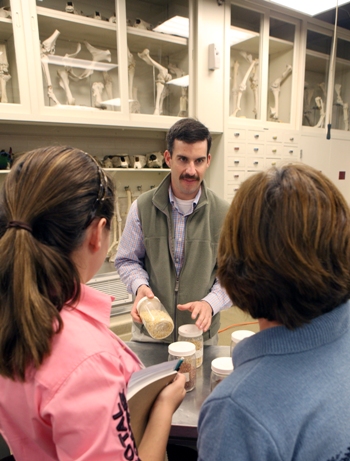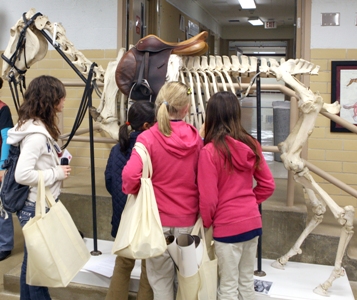From Pony Club to Veterinary School
Around one hundred and fifty pony clubbers from the Rio Grande region visited the Texas A&M College of Veterinary Medicine & Biomedical Sciences (CVM) on January 15, 2011, “Aggie Day”, to advance their Pony Club ranks and become responsible horse owners.
 Since 1994, every two years the Rio Grande Region of the United States Pony Club sponsors a large workshop at the college which is run by volunteers from the CVM.
Since 1994, every two years the Rio Grande Region of the United States Pony Club sponsors a large workshop at the college which is run by volunteers from the CVM.
The pony clubbers range in age from 8 years to 21 years old. This workshop allows for them to participate in different hands-on exercises to increase their Pony Club standings and to learn more about veterinary medicine, particularly in the equine industry.
“The pony clubbers had an opportunity to learn about anything and everything ‘equine’,” explains Michele Ward, research associate and education specialist at the CVM as well as the volunteer coordinator for this workshop. “From bits, to equine nutrition, to lameness, to anatomy and physiology, we offered just about everything. Many of the children had procedures done on their horses that they didn’t fully understand until they attended this event.”
Some of the favorite demonstrations included reproduction and ultrasound where the pony clubbers were able to see the technology being used to understand how it can help in the diagnosis and treatment of their horse. Participants also got the opportunity to place a shoe on a horse and they worked with live horses to determine body condition scoring and weight estimation. Horse nutrition and plant toxicity were important educational stations for the children who play a pivotal role in the nutrition of their horse.
Veterinary students, graduate students, veterinary technicians, and clinicians collaborated and volunteered their Saturday to help train and educate current horse owners and possible future veterinarians. Veterinary technicians Sandy Nunn, Heather Quiram, Jessie Mundy, Sheila Teague, Candise McKay, Donna Witt and the many student volunteers were especially stimulating to the Pony Club students and parents in their effort to promote the CVM hospital and its capabilities. Veterinary students and graduate students were effective in explaining animal health issues as it impacts animals and humans.
“I was amazed at the number of veterinary students, graduate students, and technicians who volunteered at this event,” notes Ward. “The pony clubbers and their parents commented on how well the veterinary students communicated and how enthusiastic they were about their topics. The veterinary students and graduate students went to great lengths to ensure that the students understood the sometimes complex topics.”
This workshop allowed for the student volunteers to develop their communication skills and to help hone their particular knowledge base in equine medicine by teaching and revisiting the subjects they learned in class. It also gives the pony clubbers the opportunity to experience equine veterinary medicine first hand and to expand their horizons concerning a topic that they are already interested in.
“This is a wonderful opportunity for our veterinary students to share the information they already learned in the classroom and to apply it to a real world situation where pony clubbers can learn and grow from it,” says Dr. Larry Johnson, professor and principal investigator of Partnerships for Environmental Education and Rural Health (PEER) at the CVM. Johnson and his team provided the instructional content for this workshop. “The pony clubbers had the opportunity to learn at their level and aspire to the next level. Our technicians did a great job expanding their knowledge about the capabilities of our teaching hospital. These folks are all horse woners and are interested in what to expect when they bring an animal to our hospital. These pony clubbers are enthusiastic about their possible future in veterinary medicine, and I believe that our volunteers helped to light that fire.”

“Many parents said it was a once in a lifetime experience to be able to get access to all of the resources we have here at the college,” says Ward. “Most of the parents were just as excited about the stations and topics as the children were. The word ‘wow’ could be heard over and over and there was an ‘aha’ moment every few seconds.”
“The PEER team would like to thank all veterinary students, graduate students, veterinary technicians, faculty, and staff who contributed to a very successful Pony Club ‘Aggie Day,'” says Johnson.


